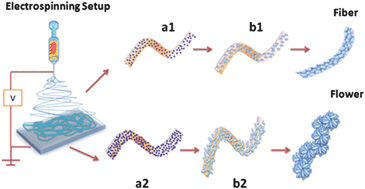High performance dye-sensitized solar cells with record open circuit voltage using tin oxide nanoflowers developed by electrospinning
Abstract
Flower shaped

* Corresponding authors
a
National University of Singapore, Singapore
E-mail:
seeram@nus.edu.sg
b
Faculty of Industrial Sciences and Technology (FIST), Universiti Malaysia Pahang, Kuantan, Malaysia
E-mail:
rjose@ump.edu.my
c Institute of Materials Research and Engineering (IMRE), A-STAR, Singapore
Flower shaped

 Please wait while we load your content...
Something went wrong. Try again?
Please wait while we load your content...
Something went wrong. Try again?
E. N. Kumar, R. Jose, P. S. Archana, C. Vijila, M. M. Yusoff and S. Ramakrishna, Energy Environ. Sci., 2012, 5, 5401 DOI: 10.1039/C1EE02703D
To request permission to reproduce material from this article, please go to the Copyright Clearance Center request page.
If you are an author contributing to an RSC publication, you do not need to request permission provided correct acknowledgement is given.
If you are the author of this article, you do not need to request permission to reproduce figures and diagrams provided correct acknowledgement is given. If you want to reproduce the whole article in a third-party publication (excluding your thesis/dissertation for which permission is not required) please go to the Copyright Clearance Center request page.
Read more about how to correctly acknowledge RSC content.
 Fetching data from CrossRef.
Fetching data from CrossRef.
This may take some time to load.
Loading related content
